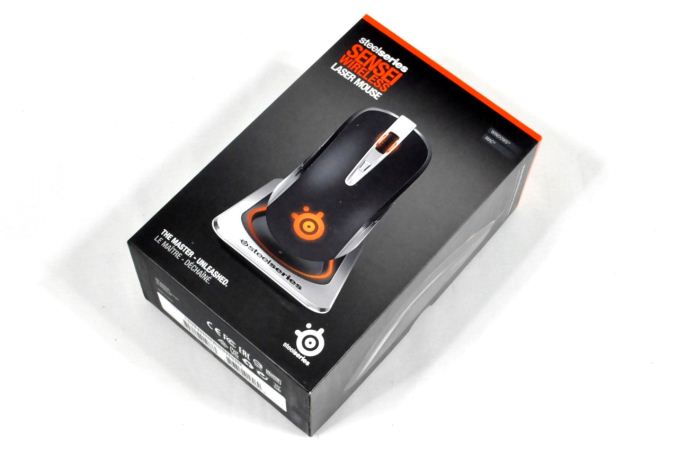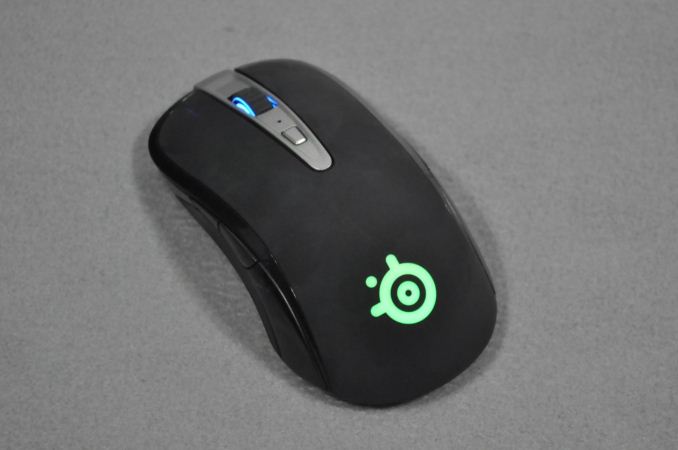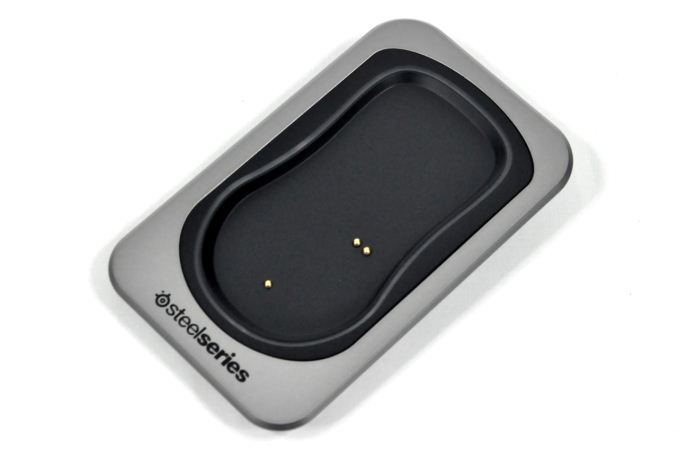Steelseries Sensei Wireless Gaming Mouse Review
by E. Fylladitakis on May 1, 2014 6:00 AM EST- Posted in
- Mouse
- Gaming
- SteelSeries

Most advanced users, especially those that are interested in gaming, have almost certainly heard of SteelSeries, a reputable manufacturer of gaming-related peripherals and hardware. The company originates from Denmark and today has offices in the US and Taiwan. They have a very large selection of products available and we cannot possibly cover them all in a single review, but today we will be having a look at their most advanced (and expensive) mouse, the Sensei Wireless.
We received the Sensei Wireless inside a simple, well-designed, hard cardboard box, which should offer ample shipping protection to the lightweight mouse. Aside from the mouse itself, the only other items inside the box are the dock, the USB cable, a company sticker, and a basic manual. There is no CD with the required software, which instead must be downloaded from the company's website.
The SteelSeries Sensei Wireless Mouse
The SteelSeries Sensei Wireless is a symmetrical mouse of classic design. It is a good choice for left handed or ambidextrous users and very comfortable for prolonged use, although perhaps not as ideal as ergonomic mice that are shaped to fit either the left or the right hand. For instance, the Sensei Wireless has two buttons on either side of the mouse. Two of these buttons can easily be pressed by a thumb but it is painfully frustrating to press the other two with your pinky or ring finger. The ribbed wheel of the mouse offers good feedback and comfort, without being too stiff or too soft. There is only one button at the top of the Sensei Wireless that, if not re-programmed, can be used to cycle through the CPI settings.
The top and sides of the SteelSeries Sensei are made of corona treated ("rubberized") plastic, which feels comfortable to the hand and improves adhesion. The company logo can be seen at the top part of the mouse, which illuminates once the mouse is powered on. You can even pick the illumination color and intensity through the software, as well as select from a couple of visual effects, such as "breathe" and "battery status". The default colors of the mouse are red and it is set on "breathe", but these can be easily changed to virtually any color combination and intensity possible.
Perhaps the most interesting feature of the Sensei Wireless is its metallic charging dock. The heavy dock has a metallic surrounding frame but its central and bottom parts are plastic. It is heavy enough so that it won't slide around on your desk and it's shaped to be a perfect fit for the mouse. It also acts as the wireless receiver, but unfortunately the fact that the wireless receiver is integrated into this large, heavy, metallic dock reduces the portability of the Sensei Wireless down to virtually zero, at least if you want to use it in wireless mode. An illuminated ring surrounds the dock, which can also be programmed via the software.
The cable that SteelSeries provides can be connected to either the charging dock or the mouse itself. This way, if you run out of battery, you can just connect the cable to the mouse and keep playing. The proprietary molding of the cable is a perfect fit for either the mouse or the dock. The connector will lock into place once attached to the mouse and you'll need to be careful and not forget about the unlocking button when removing it, as otherwise it is easy to cause permanent damage. There is a catch too; due to the proprietary shape of the connector, finding an exact replacement will be a pain should you lose or damage yours. A typical mini USB cable will fit into the dock but it will not really be a good match for the mouse.





















83 Comments
View All Comments
BrightCandle - Thursday, May 1, 2014 - link
There is a really good reason why no gamer should really touch this mouse - acceleration. The mouse has inbuilt unremoveable acceleration making the mouse primarily unsuitable for gamers.If you had done a basic sensor test you would have determined this and been able to a give a useful review instead. At one time Anandtech was famous for its indepth technical reviews, these mouse reviews are embarrassing.
Creig - Thursday, May 1, 2014 - link
According to the screenshot and the review itself, this mouse has adjustable acceleration.Omega215D - Thursday, May 1, 2014 - link
No, there's also inherent acceleration in the sensor in which if you are competitive in gaming your mouse movements may not always be 1:1 and instead may gradually move a bit faster as you try to flick shot. Some high level gamers can adapt and dominate using this mouse while others can't.You can find more info at overclock.net/f/375
Samus - Friday, May 2, 2014 - link
Why is steel series competition-issue hardware for most competitions then?F120 - Friday, May 2, 2014 - link
Because they sponsor a lot of teams. Even then, you'll find most people choose proven optical mice.geo2160 - Monday, May 5, 2014 - link
Oh, the elitism, I can not withstand it! Seriously now, to notice the acceleration innate to certain sensors, you have to be at the very top of twitch shooter competitive scene. And I bet most of the people commenting aren't there and wouldn't even notice it in a blind test. And also, stop pretending gaming grade mice are only for shooters. In RTS-es for example, acceleration is beneficial for certain playstyles, so much that the innate acceleration of the sensor is negligible even at the highest level.Wwhat - Tuesday, May 6, 2014 - link
He's simply right that acceleration you can't turn off is a no-no for gaming mouse. To try to argue such a thing is simply silly and shows you have a compulsive need to argue more than anything else.geo2160 - Wednesday, May 7, 2014 - link
Indeed, acceleration THAT YOU CAN NOTICE is a big no-no, but I doubt any of us can. I bet most of the elitists would be happily playing in their ignorance with "imperfect sensors" if it weren't for someone crazy enough to test this with the proper equipment. I must commend those enthusiasts for doing that, but I didn't expect those results to get so blown out of proportions. 120Hz monitors affect gaming performance in a much bigger way, but I don't think I saw anyone using one. I have a question for all the people fueling this "imperfect sensor" non-sense:If your reflexes and eye-to-hand coordination are so good that you can notice minuscule imperfections in sensor tracking, and those imperfections affect your performance your quake 2/CS 1.6 sessions, why don't you also go and buy a 120Hz monitor to go with your perfect sensor? Or even better, why don't you buy a CRT or whip out the one in your basement?
nathanddrews - Wednesday, May 7, 2014 - link
The only thing worse than an elitist is a hater.dsumanik - Thursday, May 8, 2014 - link
Both you STFU, the real problem here is the significant decline in anandtech journalism standards.... this like many other "articles" are blatant paid-for product advertisements under the guise of a "review". As these comments prove, a large majority of the readers here could have written a better review of this product, and are simply more informed than the person analyzing this product.... just sad Anand.